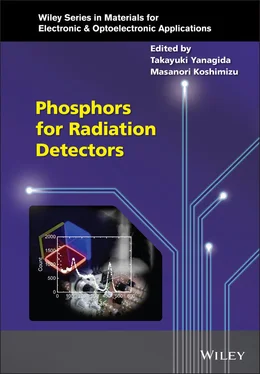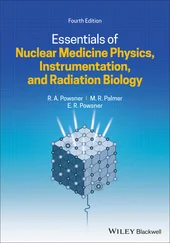Phosphors for Radiation Detectors
Здесь есть возможность читать онлайн «Phosphors for Radiation Detectors» — ознакомительный отрывок электронной книги совершенно бесплатно, а после прочтения отрывка купить полную версию. В некоторых случаях можно слушать аудио, скачать через торрент в формате fb2 и присутствует краткое содержание. Жанр: unrecognised, на английском языке. Описание произведения, (предисловие) а так же отзывы посетителей доступны на портале библиотеки ЛибКат.
- Название:Phosphors for Radiation Detectors
- Автор:
- Жанр:
- Год:неизвестен
- ISBN:нет данных
- Рейтинг книги:3 / 5. Голосов: 1
-
Избранное:Добавить в избранное
- Отзывы:
-
Ваша оценка:
- 60
- 1
- 2
- 3
- 4
- 5
Phosphors for Radiation Detectors: краткое содержание, описание и аннотация
Предлагаем к чтению аннотацию, описание, краткое содержание или предисловие (зависит от того, что написал сам автор книги «Phosphors for Radiation Detectors»). Если вы не нашли необходимую информацию о книге — напишите в комментариях, мы постараемся отыскать её.
Phosphors for Radiation Detectors
Discover a comprehensive overview of luminescence phosphors for radiation detection Phosphors for Radiation Detection,
Phosphors for Radiation Detection
Phosphors for Radiation Detection
Phosphors for Radiation Detectors — читать онлайн ознакомительный отрывок
Ниже представлен текст книги, разбитый по страницам. Система сохранения места последней прочитанной страницы, позволяет с удобством читать онлайн бесплатно книгу «Phosphors for Radiation Detectors», без необходимости каждый раз заново искать на чём Вы остановились. Поставьте закладку, и сможете в любой момент перейти на страницу, на которой закончили чтение.
Интервал:
Закладка:
In other ionizing radiations such as α‐ray, measurement is generally difficult. One easy but rough way is to use an oscilloscope for direct observation of the signal output from a detector, consisting of scintillator and photodetector by a self‐trigger mode. Although it may contain noise (e.g., thermal noise of photodetector), we can roughly observe scintillation decay time. Previously, most papers observed decay curves by such an oscilloscope measurement, but recently, a digitizer has been used to accumulate many decay curves. In such a case, we can accumulate a large amount of decay curves, and select correct decay curves by setting correct selection conditions of events. An accurate but technically difficult way is to use DCM by one scintillator sample and two photodetectors. If we take the case of α‐ray irradiation as an example, let us assume one cylindrical scintillator optically coupled with two PMTs by edge surfaces, and α‐ray is irradiated to the side of the scintillator. When the α‐ray is absorbed by the center part of the scintillator, half of the scintillation photons are transported to one PMT and the other remaining half to another PMT. We can use one of the two output signals as a start signal, and if we can reduce the number of photons in another side to a single photon, we can use it as a stop signal. In this way, we can measure scintillation decay under particle excitation.
The pulse height spectrum is one of the most important properties of scintillation detectors, because most of measurements in other scientific fields use integration‐type detectors, and pulse height (photon counting) type measurements is one of the original techniques in radiation and high energy physics. The detailed explanation is given in Chapter 12.
Typical experiments on dosimeters are described in Chapters 7(TSL), 8(OSL), and 9(RPL). In most cases, dosimeter properties are examined by X‐ray or γ‐ray irradiation, since an accessibility of high energy photons are easier than other ionizing radiations. Especially, X‐rays are mainly used for tests of individual dosimeters, because energy and amounts of X‐rays can be controlled by bias voltage and tube current in a typical X‐ray generator. In evaluations of dosimeters, the irradiated dose range should be adequate for the purpose. The lower detection limit of commercial individual dosimeters is 1–100 μGy, and experiments should be conducted from these lower detection limits to ~10 Gy. In some papers, several kGy irradiations are done, although the aim is an individual dosimeter. On the other hand, if the purpose is to monitor radiation therapy, tests of several hundreds Gy to several kGy irradiation will be valid. Another important aspect is fading. If the aim is individual dosimeters, fading should be tested at about one month, and if the aim is an imaging plate typically used in a dental clinic, three to four days' tests will be adequate. In addition to these general aspects, in evaluation of TSL properties, heating rate affects peak temperatures in the glow curve. In practical applications, the heating rate is around 10 °C/s, while 0.1–1 °C/s rate is common for studies of TSL as a physical property. In actual materials, we must consider time of heat conduction, and if the heating rate is too fast, responses of materials cannot follow. With a fast heating rate, we generally observe a relatively higher glow peak temperature than the true value, although we do not have a way to know the exact true value. When we measure TSL with a very slow heating rate, an observed glow peak temperature will be close to the true value. Another detailed explanation of the measurement technique of TSL can be found in Chapter 7.
In characterizations of OSL and RPL, we generally use common systems of PL spectrum. In OSL, after the irradiation of ionizing radiation, we put the sample in a PL machine and stimulate the sample under the adequate stimulation wavelength. In some spectrofluorometers, the automatic measurement function of PL excitation spectrum is installed, and by this function, we can easily investigate the stimulation spectrum. Unlike the PL excitation spectrum, which generally shows a clear excitation band due to electron transitions of dopant, OSL stimulation spectrum generally shows a broad unclear feature. For OSL and TSL measurements, an automation type instrument (Risø TL/OSL DA‐20 reader) is widely used ([95]). Generally, this system equips β‐ray ( 90Sr) as an irradiation source, LED as a stimulation source for OSL having typically a 470 nm emission wavelength, and a heater for TSL measurement. One of the disadvantages of this automated system is a lack of wavelength resolution, which equals to non‐determination capability on the emission origin, and some ideas are proposed to add a function of wavelength resolution [96].
In order to investigate OSL and RPL, some important aspects should be noted in actual experiments. Typically, the stimulation wavelength of OSL is longer than the emission wavelength, and resembles the situation of upconversion. In order to distinguish them, continuous stimulation is a simple way. If the phenomenon is OSL, the emission intensity decreases under the continuous stimulation, while in the case of upconversion, the intensity is constant. In addition, the stimulation wavelength of OSL is not necessarily longer than the emission wavelength, because we cannot deny the existence of a deep trap. In such a case, distinction of OSL and RPL becomes difficult. The continuous stimulation (excitation) is also a useful technique in this situation, and if the phenomenon is OSL, the emission intensity decreases with time, while that of RPL is constant against time. But in the special case where the trap depth and excitation band overlap, clear distinction is difficult. Other experimental aspects of OSL and RPL are introduced in Chapters 8and 9, respectively.
References
1 1. Röntgen, W.C. (1895). On a new kind of rays. Nature 53 (1369): 274–276.
2 2. Knoll, G. (2000). Radiation Detection and Measurement. Hoboken, NJ: Wiley.
3 3. Yukihara, E.G. and McKeever, S.W.S. (2011). Optically Stimulated Luminescence: Fundamentals and Applications. New York: Wiley.
4 4. Mckeever, S.W.S. (1985). Thermoluminescence of Solids. Cambridge: Cambridge University Press.
5 5. Schulman, J.H., Ginther, R.J., and Klick, C.C. (1951). Dosimetry of X‐rays and gamma‐rays by radiophotoluminescence. J. Appl. Phys. 22: 1479–1487.
6 6. Hofstadter, R. (1948). Alkali halide scintillation counters. Phys. Rev. 74: 100–101.
7 7. Weber, M.J. and Monchamp, R.R. (1973). Luminescence of Bi4Ge3O12: spectral and decay properties. J. Appl. Phys. 44: 5495–5499.
8 8. Laval, M., Moszyński, M., Allemand, R. et al. (1983). Barium fluoride – inorganic scintillator for subnanosecond timing. Nucl. Instrum. Meth. Phys. Res. 206: 169–176.
9 9. Jahn, A., Sommer, M., and Henniger, J. (2014). OSL efficiency for BeO OSL dosimeters. Radiat. Meas. 71: 104–107.
10 10. McElhaney, S.A., Ramsey, J.A., Bauer, M.L. et al. (1990). A ruggedized ZnS(Ag)/epoxy alpha scintillation detector. Nucl. Instrum. Methods Phys. Res. A. 299: 111–114.
11 11. Yanagida, T., Fujimoto, Y., Miyamoto, M. et al. (2014). Optical and scintillation properties of Cd doped ZnO film. Jpn. J. Appl. Phys. 53: 02BC13.
12 12. Kaneko, J.H., Izaki, K., Toui, K. et al. (2016). An alpha particle detector based on a GPS mosaic scintillator plate for continuous air monitoring in plutonium handling facilities. Radiat. Meas. 93: 13–19.
13 13. Maekawa, T., Sumita, A., and Makino, S. (1998). Thin Beta‐ray detectors using plastic scintillator combined with wavelength‐shifting fibers for surface contamination monitoring. J. Nucl. Sci. Technol. 35: 886–894.
14 14. Tzolov, M.B., Barbi, N.C., Bowser, C.T. et al. (2018). First‐surface scintillator for low accelerating voltage scanning electron microscopy (SEM) imaging. Microsc. Microanal. 24: 488–496.
Читать дальшеИнтервал:
Закладка:
Похожие книги на «Phosphors for Radiation Detectors»
Представляем Вашему вниманию похожие книги на «Phosphors for Radiation Detectors» списком для выбора. Мы отобрали схожую по названию и смыслу литературу в надежде предоставить читателям больше вариантов отыскать новые, интересные, ещё непрочитанные произведения.
Обсуждение, отзывы о книге «Phosphors for Radiation Detectors» и просто собственные мнения читателей. Оставьте ваши комментарии, напишите, что Вы думаете о произведении, его смысле или главных героях. Укажите что конкретно понравилось, а что нет, и почему Вы так считаете.












